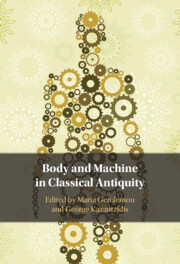Book contents
- Body and Machine in Classical Antiquity
- Body and Machine in Classical Antiquity
- Copyright page
- Contents
- Figures
- Contributors
- An Introduction to Body–Machine Intersections
- Part I Blended Bodies
- Chapter 1 More Than a Thing
- Chapter 2 Automata, Cyborgs, and Hybrids
- Chapter 3 Not Yet the Android
- Part II The Technological Body
- Part III Towards the Mechanization of the Human Body
- Index of Passages
- General Index
- References
Chapter 3 - Not Yet the Android
The Limits of Wonder in Ancient Automata
from Part I - Blended Bodies
Published online by Cambridge University Press: 13 July 2023
- Body and Machine in Classical Antiquity
- Body and Machine in Classical Antiquity
- Copyright page
- Contents
- Figures
- Contributors
- An Introduction to Body–Machine Intersections
- Part I Blended Bodies
- Chapter 1 More Than a Thing
- Chapter 2 Automata, Cyborgs, and Hybrids
- Chapter 3 Not Yet the Android
- Part II The Technological Body
- Part III Towards the Mechanization of the Human Body
- Index of Passages
- General Index
- References
Summary
Poetic, literary and philosophical dreams of automata in the ancient world tended to focus on humanoid or at least mammalian entities. Yet when automata are realised in practice, they are considerably different in quality.This chapter explores the gap between the automata of ancient fantasy and reality, in terms of their physical nature and the concepts and categories with which they were implicated (statues, slaves, theatre, the divine). It asks how far the sense of wonder that is associated with automata changed over time and how far it (ever) depended on a naturalistic or realistic reproduction of the body, human or animal. I argue that although the earliest known automata seem to have made gestures towards naturalism, both in terms of movement and other activities (if not in how these effects were realised), interest rapidly moved towards mechanical wonder (as Hero of Alexandria suggests) and theatrical wonder rather than any kind of naturalistic wonder. Perversely, the more technically sophisticated ancient automata became, the less the interest in mimicking human or animal bodies. The explanation may be sought partly in the non-naturalistic nature of ancient mimesis and partly in the changing status and sophistication of ancient mechanics. As a result, the path from ancient automata to modern notions of the robot or android is not at all straightforward.
- Type
- Chapter
- Information
- Body and Machine in Classical Antiquity , pp. 70 - 104Publisher: Cambridge University PressPrint publication year: 2023



